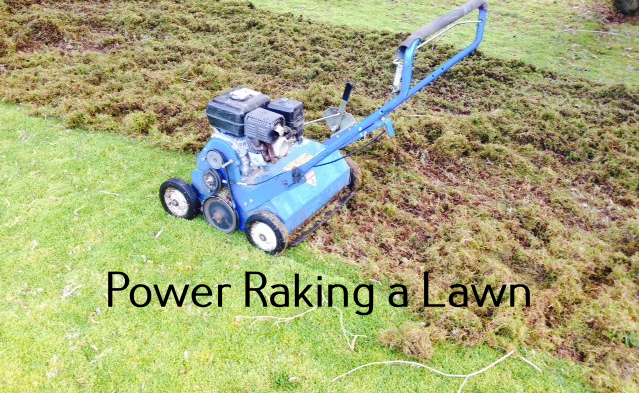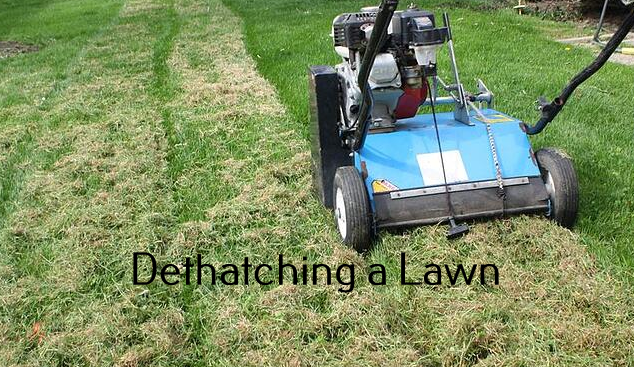A very thick layer of thatch can cause significant damage to your lawn. A buildup of dead matted grass, rhizomes, stems, and clippings between the roots and grass can stop water, nutrients, and sunlight from reaching the grass roots.
To effectively dethatch a lawn, you may use a power rake or a dethatcher depending on the size of your lawn and the thickness of the thatch. But what’s the difference between a power rake and a dethatcher?
Power Rake vs Dethatcher: Differences
Here is a summary of the differences between a power rake and a dethatcher:
| Power Rake | Dethatcher |
| Ideal for lifting and removing thatch that exceeds 1/2 inch in thickness | Mainly used to remove thatch that is up to 1/2 inch thick |
| It uses blades to slice and lift a thick layer of thatch from a lawn | It uses metal tines to remove debris and a thin layer of thatch from a lawn |
| Aggressive and heavy-duty way of dethatching a lawn | Less aggressive and moderate way of dethatching a lawn |
| It can damage healthy grass if not properly operated | There is less to no chance of damaging the healthy grass |
| A lawn will need time to recover after using a power rake | A lawn takes less time to recover |
| May need professional help to operate | Easier to operate without the need for skilled help |
| Expensive machine to purchase, thus suitable for contractors or professional landscapers | Very affordable device for gardeners or homeowners, especially the manual models |
| Suitable for large areas or commercial lawns | Suitable for small yards or residential lawns |
Power rake
A Power rake is a push-mower-like machine equipped with rotating flails and heavy-duty blades that slice and remove thatch from a lawn. Power raking is regarded as an aggressive way of removing the thick thatch from a lawn which could also damage your lawn if not properly done.
A power rake should be adjusted to the right height before the task to grab the right amount of thatch without harming the healthy grass. A lawn should be power raked if the thatch is thicker than half an inch.
A little bit of thatch helps retain moisture, cool the soil and return nutrients to the soil.
Dethatching power rakes, either electric or gas, are expensive machines suitable for large lawns. Lawn care contractors and landscapers get them very useful. You won’t get value for your power rake if you own a small lawn.
If you haven’t dethatched for years, it’s better to consider hiring the service or using a dethatcher.

Dethatcher
A dethatcher is a device that uses metal tines to remove thatch from a lawn. Using this machine is considered a less aggressive way of removing debris and dead plant materials from the base of the lawn. It pulls up less than half an inch of thatch to the lawn’s surface without stressing the grass.
A dethatcher comes in various types: manual, tow-behind, and motorized. You’ll choose one depending on various factors, including the size of your lawn, the severity of the thatch, your ability to operate, and your budget.
Manual dethatchers are the least expensive and thus highly affordable. They feature a simple design similar to a garden or leaf rake. These models are the easiest to use and ideal for hard-to-reach areas.
On the downside, manual dethatchers require physical energy to operate, thus only suitable for small lawns.
Tow-behind dethatchers can be attached to a lawn mower or garden tractor, thus making it easier to operate. They are suitable for covering considerably large yards and will do the job within a short period of time. However, they aren’t ideal for removing thatch in tight spaces.
Motorized dethatchers are typically powered by an engine or a motor. They look like push or walk-behind lawnmowers. They are easily confused for power rakes, but they have spring tines for removing thatch from a lawn.
Powered dethatchers are great for covering small to mid-sized lawns, but you will have to get deeper in your pocket to own one.

Which is better for you?
A dethatcher is a better option for small to medium-sized lawns. The light-duty tool will effectively remove a small amount of dead and living organic debris from the surface of the lawn without damaging the healthy grass.
You don’t need any special skill to use a dethatcher in managing thatch in your lawn.
A power rake, on the other hand, is suitable for large fields with thick thatch. The equipment is expensive to acquire and not worth the effort if you are a homeowner with a small to medium-sized lawn.
This is a must-have machine for lawn care professionals and landscapers who operates at a profit.
Also read: Dethatch or Aerate First?
Final Thought
Signs of excessive thatch in a lawn include; brown spots resulting from lack of water, thinning grass, and a spongy feeling when you walk on your lawn. If you decide to dethatch your lawn, use either a dethatcher or power rake based on the size of your lawn and the thickness of thatch.